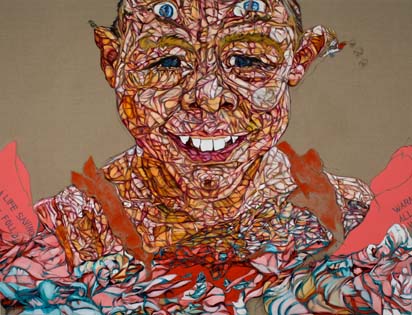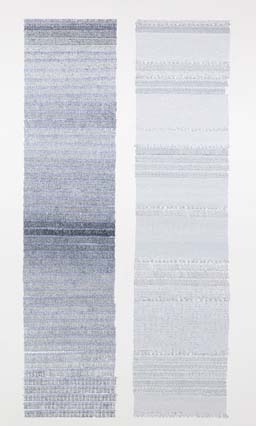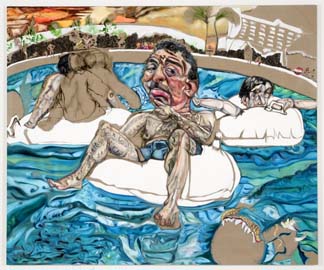Interview with Schandra Singh
1. How did you start making art?
At the age of 15 I started to draw. The work was very private and personal, a kind of emotional diary. The drawings were technically imperfect so I kept them a secret. I didn’t look at them as art but as a personal expression. My mother discovered the drawings while we were traveling in Europe. She then got me a membership at MOMA. I attended the opening of a Matisse retrospective. I was amazed at how Matisse deconstructed the figure, left numerous outlines and was completely free. He showed me that I didn’t need to hide from what I found imperfect in my work, and that it had a place in this world.
Untitled, 2003, Oil and gouache on canvas, 84″ x 54″
2. Briefly describe your art from the perspective of what it could tell us about you?
The work tells the viewer about my own internal struggle. To me it shows how I walk through life taking in so many tensions and still being able to smile. To really see behind the mask of our outside image. What the tension in the work tells the observer about me is what it should be telling them about themselves. What it means to be human, addressing our internal and external lives.
3. What experiences have most influenced your choice of subject matter, medium and style?
At age 24 my life forever changed. I lived across the street from Tower Two of the World Trade Center. I had my home and studio there and was there on the morning of September 11th. I experienced all of the horrors of that day, barely escaping with my life. At this point, the notion of my own internal struggle heightened. The concept of what it means to live with my own horrors and the horrors of the world collided. I paint people now trying to rest in the midst of a world in unrest.
While at my hotel on vacation in the Bahamas I was looking at a middle aged man floating on an inner tube coming down an artificial river. This man could be anyone, and his form of relaxation was floating down a fake river on a child’s toy. I thought to myself how funny this was. I also thought I would like to do a large painting of this, but instead of painting him relaxing I would depict his internal discomfort. To paint an existential crises, in the midst of what appeared to be paradise. This experience is what led to my creation of the painting ‘The Lazy River’ which started the series of paintings that define my current body of work.
I paint on linen which is less plastic than canvas and can better depict earthy raw feelings.
The Lazy River, 2006, Oil on linen, 90″ x 108″
4. Is your formal or informal training as an artist useful? How?
My formal training was extremely helpful as I had the passion but needed other skills. My time at RISD helped to develop the tools that I needed to fuel my already strong desire for making art. Then going to Yale was very important. It put forth challenges and brought things to a boiling point where I had to really prove my passion. I was encouraged there to work in new and demanding ways.
My informal training is life.
5. Does your work reflect issues in yourself, in society, or in the community?
Yes, very much so. It is about myself. Through painting other people I am addressing my own existential crises such as the privilege of laying on a beach in paradise or eating three meals a day while others can not. What does it mean to know you have things and that others don’t? Sometimes it is in your face, on the street, and sometimes more subtle. I purposely choose environments of paradise to talk about the exact opposite, to talk about how we ‘float’ through life, and how we may be floating externally, but are sinking internally.
6. What would you say is the purpose for making art?
There are so many purposes for making art. Yet I strongly believe that one purpose for making art is to complete us. We think we need to be practical and one forgets that what it means to be human is to be emotional, to dream and contemplate. The artist works to fill this void, and make it available to others.

Pualani,2010, Oil on linen, 82″ x 108″
7. Do you appreciate culturally specific works of art? If so how does your personal and cultural background show up in your work?
I appreciate culturally specific works of art and they have their place in the world. My work is not culturally specific, as I don’t feel culturally specific. Being of Indian and Austrian decent I grew up in an environment where there were many different cultures. I don’t shy away from painting subjects from other cultures but culture is not the key to my work. Culturally specific art is wonderful, but in my work I want to be able to move further than the particular and express the universality of human experiences, going beyond culture.
8. Is there anything you would like to say about your local art scene or the international art market, art education, and or system for art exhibition?
Art education is so important. It is sad when it is taken for granted and when people don’t think about the emotional benefit of artistic exposure and expression.
8. How does your current portfolio fit into the rest of your body of work?
Hmm. We will have to see.




